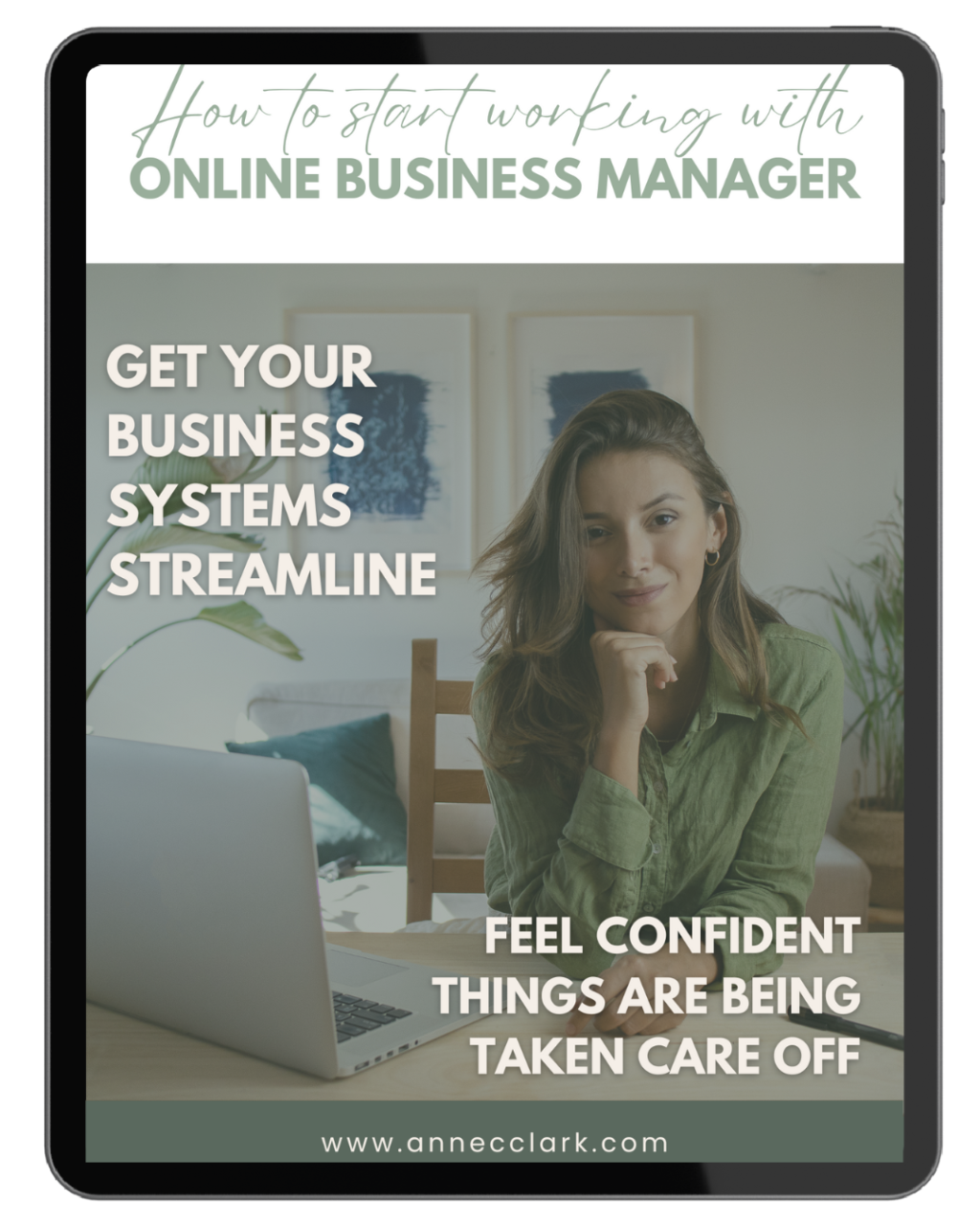
by Anne Clark | Sep 16, 2024 | Business, Email Marketing, Mailchimp
Top Strategies for Building and Expanding Your Email List Effectively
Your email list is one of the most valuable assets you can have. It’s not just a collection of names and addresses; it’s a direct connection to your audience – people who have shown interest in what you offer. But how do you build and grow an email list effectively? Here are some best practices that will set you up for success.
1. Create Valuable Lead Magnets
Lead magnets are incentives you offer to your audience in exchange for their email addresses. This could be a free ebook, checklist, template, webinar, or discount. The key is to offer something valuable and relevant to your audience. If what you offer solves a problem or provides a useful resource, people will be much more likely to sign up.
Tip: Ensure that your lead magnet aligns with your audience’s needs and the services or products you offer.
2. Make Your Signup Forms Easy and Visible
Don’t make people search for your signup form. Place it in prominent locations on your website, like the header, footer, or as a pop-up. Keep the form simple – only ask for essential information such as a name and email address. The more fields you add, the less likely people are to sign up.
Tip: Test different locations for your signup form (homepage, blog posts, or even landing pages) to see where it performs best.
3. Use Strong Call-to-Actions (CTAs)
Your signup forms need clear, compelling CTAs that encourage visitors to take action. Instead of using the generic “Subscribe” button, try something more engaging like “Get Your Free Guide,” “Start Your Journey,” or “Join Our Exclusive Community.”
Tip: Your CTA should highlight the value they’ll get after signing up, not just the act of subscribing.
4. Segment Your List Early
As your email list grows, it’s important to segment it based on interests, behaviours, or demographics. This allows you to send targeted emails that resonate with specific groups, leading to higher engagement and conversion rates.
Tip: You can segment your list based on where subscribers signed up, what lead magnet they downloaded, or their purchasing behaviour.
5. Optimise for Mobile
Many people check their emails on their phones, so it’s crucial that your signup forms and emails are mobile-friendly. Make sure the forms are easy to fill out on small screens, and that your emails are optimised for mobile viewing.
Tip: Test your forms and emails on various devices to ensure a smooth user experience.
6. Leverage Social Proof
People are more likely to join your list if they see others have already done so. Add testimonials, reviews, or display how many others have signed up to your email list. This kind of social proof can build trust and make people feel more confident in joining.
Tip: Include case studies or success stories related to your lead magnets to further enhance your credibility.
7. Utilise Pop-Ups Strategically
When used wisely, pop-ups can be a highly effective way to grow your email list. Time them so they don’t interrupt the user experience – consider exit-intent pop-ups or delayed triggers to give visitors time to engage with your content first.
Tip: Keep your pop-ups simple and focused on your lead magnet with a clear CTA.
8. Offer Exclusive Content
One of the best ways to keep people on your list and encourage others to join is to provide exclusive content that they won’t find anywhere else. Whether it’s a members-only newsletter, early access to products, or special offers, make sure your subscribers feel valued.
Tip: Tease exclusive content on social media or in your blog to encourage signups.
9. Encourage Sharing
Encourage your current subscribers to share your emails with friends and family. Include social sharing buttons and forward-to-a-friend links in your emails. This can help expand your list organically through word-of-mouth referrals.
Tip: Reward subscribers who refer others with a small gift, discount, or exclusive content.
10. Consistently Deliver Value
Building your list is one thing, but keeping it engaged is another. To retain subscribers and keep growing, you must consistently provide valuable content. Whether it’s educational, entertaining, or promotional, ensure that your emails offer something useful to your audience.
Tip: Set up a welcome email sequence that immediately delivers value after someone signs up to build a relationship from day one.
If you need help establishing your newsletter and email marketing, then please feel free to reach out to me.

by Anne Clark | Sep 4, 2024 | Business, Website
Setting up a website? Take note! You might be making some legal mistakes that could cost your business dearly. Small businesses often overlook these crucial aspects, risking lawsuits, fines, and damaged reputations. Let’s explore the legal mistakes small businesses make on their websites.
Before you freak out, here is my amazing go-to for all legals requirements – Legal123.com.au, you will find all you need here. I highly recommend them.
Now, let’s get to it. Here’s a jaw-dropping look at the top legal pitfalls you need to make sure you’re avoiding.
Privacy Policy? What’s That?
You won’t believe how many businesses neglect to include a privacy policy on their websites. This vital document outlines how you collect, use, and protect user data. Without it, you’re playing with fire, risking massive fines and legal battles. Don’t make this rookie mistake!
According to Legal 123 all Australian websites need a Privacy Policy.
Privacy legislation, whilst not legally required (yet), I would strongly encourage you to play it safe, especially if you’re collecting any customer or website visitor information:
- Email addresses
- Physical addresses
- Telephone numbers
- Credit card numbers, etc.
So even if you have a basic Contact Form on your website, you MUST have a Privacy Policy.
No Terms and Conditions? You’re Asking for Trouble
Are you running your website without terms and conditions? This is a ticking time bomb! T&Cs protect you from liability and set the rules for user conduct. Without them, you’re leaving your business wide open to disputes and potential lawsuits.
According to Legal 123:
“Website Terms & Conditions are a legal notice which states the terms that visitors, users and customers of your website must agree to in order to browse your website or use your products and services.
It protects you from customers claiming to have suffered loss from your content or using your products or services. It also protects you from visitors to your website copying your content, claiming damages from viruses, etc. It is intended to cover visitors, users, purchasers of your products and subscribers to your services.
Website Ts&Cs are intended for users, subscribers and customers of your website. By contrast, a Website Disclaimer is less comprehensive and just intended for general website visitors.”
Ignoring Cookie Consent: A Recipe for Disaster
If you think cookies are just a sweet treat, think again! Failing to get user consent for cookies can lead to severe penalties, especially under GDPR. Don’t get caught in this trap—implement a cookie consent banner now!
You can learn more about comply with GDPR here.
Copyright Infringement: The Silent Business Killer
Using images and content without permission? You’re flirting with copyright infringement! Many small businesses make this costly mistake. Always use properly licensed material or create your own to stay on the right side of the law.
Here is a great infographic explaining what you need to know.
Source: Copyright Infringement: Myths vs Facts from Legal123.com.au
Data Security Failures: Are You Next in Line for a Breach?
Data breaches are rampant, and your business could be next. Failing to secure user data isn’t just irresponsible—it’s illegal! Implement robust security measures to protect your customers and your business from devastating consequences.
E-commerce Errors That Could Bankrupt You
Selling online? You better be compliant with e-commerce regulations! From clear pricing to transparent return policies, there are numerous rules to follow. Don’t let ignorance cost you—get your e-commerce house in order.
Email Marketing Mishaps: Are You Breaking the Law?
Think you can send marketing emails without consequences? Think again! Laws like the CAN-SPAM Act require explicit consent and an easy opt-out option. Violate these rules, and you could face hefty fines and a damaged reputation.
Outdated Policies: A Lawsuit Waiting to Happen
When was the last time you updated your website’s legal policies? Outdated policies can lead to legal troubles. Regularly review and update your policies to stay compliant and protect your business from unexpected legal challenges.
DIY Legal Documents: A Recipe for Legal Disaster
Using generic legal templates? This could be your downfall! Poorly drafted documents might not cover your specific needs, leaving you vulnerable. Invest in professional legal advice to safeguard your business from potential disputes.
Don’t let these shocking legal mistakes derail your small business! By addressing these pitfalls, you can protect your business, build trust with your customers, and focus on growth. Stay vigilant, stay compliant, and watch your business thrive.
Again, let’s not panic and just get it fixed now. I always recommend to my clients when building their website to reach out to Legal 123 for everything they need.
I do encourage you to take the time to learn about these key elements and ensure you are in compliance. And if you get stuck, reach out to Legal 123.

by Anne Clark | Aug 28, 2024 | Business, Digital Marketing
Part 4: Converting Leads into Clients: Strategies and Best Practices
Converting leads into clients requires a strategic approach to move prospects through the final stages of the sales funnel. In this final part of my series, I’ll explore effective strategies to close deals and turn leads into loyal customers.
1. Develop a Follow-Up Strategy
- Structured Plan: Create a clear plan for following up with leads, including the timing and method of contact. For example, follow up with a phone call a week after sending an initial email.
- Multi-Channel Approach: Use a mix of communication channels such as email, phone, and social media to stay in touch with leads and keep your brand top-of-mind.
2. Address Common Objections
- Identify Objections: Anticipate common objections or concerns leads may have and prepare thoughtful responses. For instance, if price is a concern, be ready to discuss the value and ROI of your offering.
- Provide Solutions: Offer solutions or alternatives to address objections and reassure leads. For example, if a lead is hesitant about the cost, offer flexible payment options or a money-back guarantee.
3. Offer Free Consultations or Demos
- Consultations: Schedule free consultations to discuss the lead’s specific needs and demonstrate how your product or service can address them.
- Demos: Provide live or recorded demonstrations of your product to showcase its features and benefits in action.
4. Implement a Lead Scoring System
- Assign Scores: Create a system for scoring leads based on factors such as engagement level, demographic fit, and purchase intent. For example, assign higher scores to leads who have interacted with multiple pieces of content or attended a webinar.
- Prioritise Leads: Focus your efforts on high-scoring leads who are more likely to convert, and tailor your approach based on their score.
5. Create a Sense of Urgency
- Limited-Time Offers: Use time-sensitive promotions or discounts to encourage leads to act quickly. For example, offer a special discount for leads who sign up within the next 48 hours.
- Scarcity Tactics: Highlight limited availability or exclusive access to create a sense of urgency. For instance, “Only 10 spots left for our premium coaching programme!”
6. Analyse and Refine Your Approach
- Review Results: Regularly assess the effectiveness of your conversion strategies by reviewing conversion rates, feedback, and other relevant metrics.
- Continuous Improvement: Make data-driven adjustments to your approach based on insights and trends. For example, if a particular follow-up tactic is not yielding results, experiment with different methods or messaging.
By mastering these effective lead generation techniques, you can attract high-quality leads, nurture them through targeted strategies, and ultimately convert them into satisfied clients. Keep refining your approach and stay tuned for more insights to help your business succeed online.

by Anne Clark | Aug 26, 2024 | Business, Digital Marketing, LinkedIn
LinkedIn newsletters are a powerful tool for professionals looking to establish authority in their industry, share insights, and stay connected with their audience. Here’s a step-by-step guide on how to set up a LinkedIn Newsletter and tips to effectively grow your audience.
Setting Up Your LinkedIn Newsletter
Step 1: Check Eligibility
Before you can start a newsletter, you need to have access to LinkedIn’s publishing platform. This feature is available to users who meet specific criteria, such as having a history of content creation or a certain number of connections. Ensure you meet these prerequisites to access the newsletter feature.
Step 2: Activate the Newsletter Feature
- Go to your LinkedIn homepage and navigate to the ‘Write an Article’ section.
- If you are eligible, you’ll see an option to ‘Create a newsletter’.
- Click on it, and you’ll be prompted to fill in details about your newsletter.
Step 3: Define Your Newsletter
- Name: Choose a catchy and relevant name that reflects the content and purpose of your newsletter.
- Description: Write a concise description that highlights the value your newsletter offers to subscribers.
- Publishing Cadence: Decide how often you’ll publish. It could be weekly, biweekly, or monthly. Consistency is key to keeping your audience engaged.
Step 4: Design Your First Edition
- Create compelling content that provides value to your readers. Whether it’s industry insights, professional tips, or career advice, ensure that your content resonates with your target audience.
- Add relevant images, videos, and links to enhance your message and engage readers.
Step 5: Publish and Promote
- Once you’re satisfied with your content, hit publish.
- Promote your newsletter on your LinkedIn profile, status updates, and other social media platforms to increase visibility.
Tips to Grow Your LinkedIn Newsletter Audience
1. Leverage Your Existing Network Encourage your LinkedIn connections to subscribe by sharing your newsletter in your posts and status updates. Personal messages to select connections who might benefit from your newsletter can also be effective.
2. Engage with Your Audience Interaction is crucial. Respond to comments, questions, and feedback on your newsletters. Engaging with your readers builds a community and fosters loyalty.
3. Collaborate with Other Professionals Feature guest posts from other industry professionals or mention their work in your newsletter. They are likely to share your content with their audience, which can increase your visibility and subscriber count.
4. Utilise LinkedIn Groups Share your newsletter in relevant LinkedIn groups (always follow the group’s guidelines). This can introduce your content to a highly targeted audience interested in your topic.
5. Optimise for Search Use relevant keywords in your newsletter title and description to make it searchable on LinkedIn and beyond. This SEO practice helps in attracting organic traffic to your newsletter.
6. Consistency Is Key Maintain a regular publishing schedule. Consistent posting keeps your audience engaged and helps build anticipation for your next edition.
7. Offer Exclusive Content Provide content that is exclusive to your newsletter subscribers to make them feel valued. This could include in-depth analyses, downloadable resources, or early access to your events or services.
8. Monitor Analytics LinkedIn provides analytics for newsletters, which include data on views, engagement, and subscriber demographics. Use this information to refine your content strategy and better cater to your audience’s interests.
Creating and growing a LinkedIn newsletter takes time and dedication, but with the right approach, it can significantly enhance your professional brand and broaden your network. Start today, and with persistence, you’ll see your efforts pay off!

by Anne Clark | Aug 7, 2024 | Business, Email Marketing
Over the next four articles, I will outline Effective Lead Generation Techniques, including crafting irresistible lead magnets, designing high-converting landing pages, nurturing leads through effective email campaigns, and converting leads into clients – strategies and best practices.
Part 1: Crafting Irresistible Lead Magnets
Lead magnets are essential tools for attracting and capturing potential clients. They offer something of value in exchange for contact information, helping you build a list of engaged leads. This first part of my series will explore creating lead magnets that truly resonate with your target audience.
1. Understand Your Audience’s Pain Points
-
Conduct Research: Use surveys, focus groups, or social media polls to gather insights on what problems or challenges your audience is facing. For example, if you run a business coaching service, find out if your audience struggles with time management or client acquisition.
-
Analyse Competitor Offerings: Review what lead magnets your competitors are using and identify any gaps or opportunities to provide something unique or more valuable.
-
Create Buyer Personas: Develop detailed profiles of your ideal clients, including their demographics, interests, and pain points. Use these personas to tailor your lead magnet to meet their specific needs.
2. Choose the Right Type of Lead Magnet
-
E-books and Guides: Write comprehensive content on a topic your audience finds valuable. For instance, if you offer digital marketing services, create an e-book titled “10 Proven Strategies to Boost Your Online Presence.”
-
Checklists: Design a step-by-step checklist that simplifies a complex task. An example could be “The Ultimate Checklist for a Successful Product Launch.”
-
Templates: Provide downloadable templates that save time and effort, such as “Social Media Post Templates for Small Business Owners.”
-
Webinars and Workshops: Host a live or recorded session on a relevant topic. For example, “How to Build a High-Converting Sales Funnel” could attract leads interested in improving their marketing strategies.
-
Free Trials or Samples: Offer a limited-time trial of your product or service. For instance, a free trial of your software or a sample of your consulting services can give potential clients a taste of what you offer.
3. Design for Value and Appeal
-
Visual Design: Use professional design tools or hire a designer to create a visually appealing lead magnet. Ensure it aligns with your brand’s aesthetics and is easy to navigate.
-
Compelling Headlines: Craft headlines that clearly communicate the benefit of the lead magnet. For example, “Unlock the Secrets to Growing Your Business Online” is more compelling than “Free E-book.”
-
Content Quality: Ensure the content is well-researched, valuable, and actionable. Avoid fluff and focus on providing real solutions or insights.
4. Create a Strong Call-to-Action (CTA)
-
Clear Instructions: Your CTA should guide the user on exactly what to do next, such as “Download Now” or “Sign Up for Free.”
-
Highlight Benefits: Emphasise what the user will gain by taking action. For instance, “Get Instant Access to Proven Strategies for Increasing Your Sales.”
-
Placement: Position your CTA prominently on your landing page or within your content to ensure it catches the user’s eye.
5. Test and Optimise
-
A/B Testing: Create different versions of your lead magnet to test which performs better. For instance, you could test two different e-book titles or formats.
-
Collect Feedback: Ask users for feedback on your lead magnet to understand what they liked or what could be improved.
-
Monitor Performance: Track metrics such as download rates or sign-up conversions to gauge the effectiveness of your lead magnet and make necessary adjustments.
If you need help building your lead magnets, please feel free to reach out and learn more about how I can support you.















